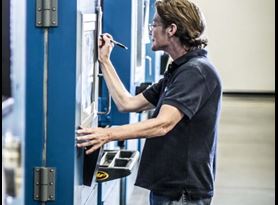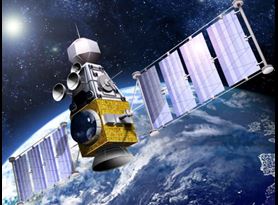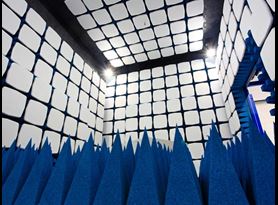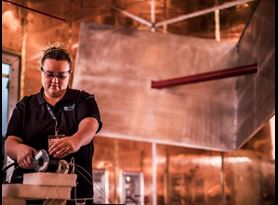Electromagnetic Compatibility (EMC) Testing in Space

James Daniels is the General Manager of Element’s Connected Technologies business in the UK, currently responsible for Operations in our Hull, Skelmersdale, Malvern, Wimborne and Oxford laboratories.
EMC tests make sure that electronic devices don't produce too much electromagnetic radiation, and that space equipment continues to work properly.
In theory, space products should be straightforward to design and certify since there are fewer electronics in space than on Earth, but in reality, space presents a greater challenge than other electromagnetic environments.
A space system needs to operate without performance degradation. During the various stages of a space system's mission: pre-launch, launch, and deployment, the EMC environment will change.
EMC in space - challenges
If EMC challenges are not correctly addressed in space systems, it can cause costly mission failures. To ensure success, EMC engineering must be robust. This includes an emphasis on detailed understanding, continuous assessments, extensive testing, and continuous vigilance throughout the project lifecycle.
There are tried and tested EMC techniques that can solve EMC problems. However, as space programs employ multiple contractors, management, integration, and partitioning become crucial to their success.
Space engineering
Space engineering has unique EMC phenomena, which include:
- Plasma charging
- Magnetic cleanliness
- Passive intermodulation
- Nuclear effects
- HIRF (High-Intensity RF)
- Conducted emissions
- Conducted susceptibility
- Radiated emissions
- Radiated susceptibility
Spacecraft charging (plasma charging)
Spacecraft charging is the build-up of electrostatic charge on spacecraft surfaces or in the interior. Differential charging is when there is a potential difference between two parts of a spacecraft. This can happen when the electrostatic potential of the spacecraft's surface varies in relation to the surrounding plasma environment.
The primary settings which contribute to spacecraft charging include:
- The thermal plasma environment
- High-energy electrons
- Solar radiation
- Magnetic fields
Spacecraft charging has many effects. Differential charging rather than absolute charging is the most dangerous. It can lead to surface arcing or electrostatic discharges (ESD) between surfaces and give rise to various operational anomalies. To combat irregularities, design solutions include conductive bonding between different surfaces and applying conductive surface treatments to non-conductive surfaces.
Magnetic cleanliness
The Earth's magnetic field is a magnetic dipole that is displaced from the center of the Earth by ~ 436 km. The Earth’s DC magnetic field is used for altitude navigation purposes.
It is crucial to control and measure the DC magnetic fields within the spacecraft in case the payload is susceptible. (note: these methods of measurement do not appear in any Military Standard). Element’s experts have created unique test methods to achieve these fundamental goals.
Passive intermodulation
Spacecraft employ multiple onboard radio transmitters and receivers for command, control, navigation, and communications. These co-located transmitters may cause unwanted passive intermodulation products and create electromagnetic interference with other wireless systems because of frequency mixing.
As experts in the field of traditional transmitter/receiver testing, Element is well-placed to advise and perform these measurements. We quantify the effects as passive intermodulation as required by the European Cooperation for Space Standardization (ECCS) and others alike.
HIRF (High-Intensity Radio Frequency)
Radar, radio, television, and other ground-based, ship-borne, and airborne RF transmitters transmit electromagnetic RF energy, creating electromagnetic HIRF. HIRF can upset or damage any electrical equipment, notably a spacecraft during the launch or tracking phase of the deployment. HIRF assessment involves extremely high levels of energy and only a few test facilities can offer these services, including Element.
Nuclear effects
An electromagnetic pulse (EMP), sometimes called a transient electromagnetic disturbance, is a short burst of electromagnetic energy. It may originate from natural or human-made sources and can occur as a radiated, electric, or magnetic field.
It can also occur as a conducted electric current, depending on the source. These ionizing effects may adversely affect a spacecraft’s electronics. Element can test for the secondary effects of a NEMP explosion and help with the electronic design if required.
Lightning environment
There is a requirement to protect the space system against both the direct and indirect effects of lightning. Testing at the system level is not essential but shall be verified by analysis. At Element, we have the expertise to test for both direct and indirect effects as well as offer design advice.
EMC test and certification
Some of the well-known EMC phenomena can be a challenge to test. For example, for radiated emissions, electric field, 30 MHz to 18 GHz, the test method is taken from Military Standard 461.
Spacecraft limits can be highly demanding in specific notches (usually in the communication bands). It is not possible without deviating from the standard to measure below the limit due to noise floor issues. The standard states to use a broadband horn antenna with physical dimensions giving a large antenna factor. Using the specified capacity, in most cases, it is not possible to be below the limit line.
At Element, we have many horn antennas that can be used for the measurement. These have a high gain and therefore a lower antenna factor. The antenna factor is added to the receiver reading which makes the overall measurement. By using a high gain horn antenna we can lower the noise floor while keeping the standard bandwidth.
Another challenge is the very low levels of field strength sometimes required of less than 1 V/m. Products require testing to ensure they work as intended and within their performance limits. Care needs to be taken not to over-test given the modest levels. Testing can be a challenge as RF field sensors do not have the sensitivity to measure low field strengths.
How Element can help with EMC testing and certification
EMC testing and certification for a space environment require bespoke tests and sensitive measurements. With Element's advisory services team, you can access a portfolio of testing facilities and engineering expertise for your EMC testing in space.
Our services include generating control plans, test plans, and test data, defining test methods, and providing guidance on de-risking and design. Our experts can help from the R&D phase right through to product launch.
For more information on EMC testing in space and EMC testing certification services, please contact us now.
Find related Resources
Related Services

Space Testing Services
Element's space testing services provide product qualification testing for aviation, satellite and space industries.

ASTM E595 Outgassing Services
Our ASTM E595 testing service evaluates polymers and nonmetallic materials for the determination of outgassing properties for the purpose of qualification for space applications.

EMI EMC Testing
Element’s global EMI and EMC testing services include programs for aerospace, defense, medical devices and commercial products.

Aerospace EMI/EMC Testing
Element has a proven record of delivering high-volume EMI/EMC testing to meet standards such as RTCA/DO-160 for civil aircraft requirements.

